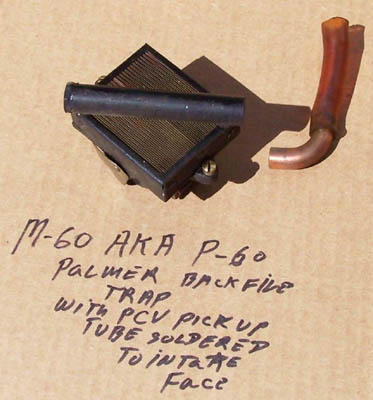|
| Palmer P60 crankcase vent |
| Author |
Message |
    
Todd Taylor
New member
Username: tangaroa3
Post Number: 1
Registered: 03-2010
| | Posted on Tuesday, April 06, 2010 - 03:24 pm: | 




|
I was hoping to get some insight, clarification or opinions about the crankcase vent on the Palmer P60.
After a full rebuild on my engine (I love this engine!) some 8 years ago, I still get some blow by smoke out the dip stick vent. Not too bad and not all the time, and the engine runs great otherwsie, so I tend not to worry about it so much, but I have been cleaning and squaring away the engine space this spring and giving some thought as to how I might remedy the problem.
As I understand it, there is supposed to be a short hose from the crank case vent to just in front of the intake side of the carbeurator for the purpose of providing a slight vacuum pressure in the crankcase. Is this correct? I don't have this. Will adding this hose help the smoking problem. What about introducing 'dirty' air to the intake? Any repercussions with this?
What if I ran a hose from the crank vent to the mouth of the bilge exhaust blower which is nearby and always on when the engine is running? Will this effectively provide the same function without introducing bad air to the intake? I appreciat any thoughts.
Also, any opinion on retourqing head bolts periodically (raw water cooled w/ copper head gasket)? |
    
Richard A. Day Jr.
Senior Member
Username: richardday
Post Number: 859
Registered: 11-2003

| | Posted on Tuesday, April 06, 2010 - 06:11 pm: | 




|
Behind the carburetor toward the flywheel end of the engine you will find on the valve cover a 1/2" pipe el. This should have short length of plastic tube aft to the side of the backfire trap over the carb intake. The air flow over the short length of pipe on the face of the backfire trap creates a vaccum and it sucks the air out of the crankcase. The oil filler cap contins a screen material which needs to be washed out in gasoline at least once a year. The smoke being sucked into the carb does no harm to the engine or its performance. this system is refered to as a positive crankcase ventilation system. PCV system. I will try to attach a picture of the typical backfire trap used on the P-60. As for retorking I leave that to other. Myself I leave thing alone which are not creating problems.  |
    
Todd Taylor
New member
Username: tangaroa3
Post Number: 2
Registered: 03-2010
| | Posted on Wednesday, April 07, 2010 - 10:56 am: | 




|
Thanks Richard,
You have always been so helpful and responsive to my questions about this engine.
I have the same backfire trap.
In the picture you provided, with the tube soldered to the intake, I assume that tube has either holes or a slot on the side facing the intake?
Would it be sufficient to run a hose from the crankcase vent so that the other end simply ended in front of the intake?
Any opinion on plan B?....running a hose from the crankcase vent into the mouth of the bilge exhaust blower, which is always on when the engine is running? |
    
Richard A. Day Jr.
Senior Member
Username: richardday
Post Number: 860
Registered: 11-2003

| | Posted on Wednesday, April 07, 2010 - 12:51 pm: | 




|
Run the tube to the valve cover and stop alternatives. You want to suck the fumes out of the crankcase and out the exhaust pipe I have no idea how explosive your crankcase fumes can be. The PCV system has proven itself over mamy years and I don't want any part of messing about with it. You are on your own. |
    
Todd Taylor
New member
Username: tangaroa3
Post Number: 3
Registered: 03-2010
| | Posted on Wednesday, April 07, 2010 - 01:28 pm: | 




|
Got it. Thanks again. |
|
|
|


|


